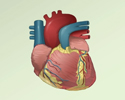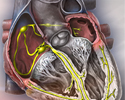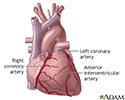Atrial fibrillation or flutter
Auricular fibrillation; A-fib; Afib
Atrial fibrillation or flutter is a common type of abnormal heartbeat. The heart rhythm is fast and most often irregular.
Causes
`When working well, the 4 chambers of the heart contract (squeeze) in an organized way.
Electrical signals direct your heart to pump the right amount of blood for your body's needs. The signals begin in an area called the sinoatrial node (also called the sinus node or SA node).
In atrial fibrillation, the electrical impulse of the heart is not regular. This is because the sinoatrial node no longer controls the heart rhythm.
- Parts of the heart cannot contract in an organized pattern.
- As a result, the heart cannot pump enough blood to meet the body's needs.
In atrial flutter, the ventricles (lower heart chambers) may beat very rapidly, but in a regular pattern.
These problems can affect both men and women. They become more common with increasing age.
Common causes of atrial fibrillation include:
- Alcohol use (especially binge drinking)
- Coronary artery disease
- Heart attack or heart bypass surgery
- Heart failure or an enlarged heart
- Heart valve disease (most often the mitral valve)
- Hypertension
- Medicines
- Overactive thyroid gland (hyperthyroidism)
- Pericarditis
- Sick sinus syndrome
Symptoms
You may not be aware that your heart is not beating in a normal pattern.
Symptoms may start or stop suddenly. This is because atrial fibrillation may stop or start on its own.
Symptoms may include:
- Pulse that feels rapid, racing, pounding, fluttering, irregular, or too slow
- Sensation of feeling the heart beat (palpitations)
- Confusion
- Dizziness, lightheadedness
- Fainting
- Fatigue
- Loss of ability to exercise
- Shortness of breath
Exams and Tests
The health care provider may hear a fast heartbeat while listening to your heart with a stethoscope. Your pulse may feel fast, uneven, or both.
The normal heart rate is 60 to 100 beats per minute. In atrial fibrillation or flutter, the heart rate may be 100 to 175 beats per minute. Blood pressure may be normal or low.
An ECG (a test that records the electrical activity of the heart) may show atrial fibrillation or atrial flutter.
If your abnormal heart rhythm comes and goes, you may need to wear a special monitor to diagnose the problem. The monitor records the heart's rhythms over a period of time.
- Event monitor (3 to 4 weeks)
- Holter monitor (24-hour test)
- Implanted loop recorder (extended monitoring)
Tests to find heart disease may include:
- Echocardiogram (ultrasound imaging of the heart)
- Tests to examine the blood supply of the heart muscle
- Tests to study the heart's electrical system
Treatment
Cardioversion treatment is used to get the heart back into a normal rhythm right away. There are two options for treatment:
- Electric shocks to your heart
- Drugs given through a vein
These treatments may be done as emergency methods, or planned ahead of time.
Daily medicines taken by mouth are used to:
- Slow the irregular heartbeat -- These drugs may include beta-blockers, calcium channel blockers, and digoxin.
- Prevent atrial fibrillation from coming back -- These drugs work well in many people, but they can have serious side effects. Atrial fibrillation returns in many people, even while they are taking these medicines.
A procedure called radiofrequency ablation can be used to scar areas in your heart where the heart rhythm problems are triggered. This can prevent the abnormal electrical signals that cause atrial fibrillation or flutter from moving through your heart. You may need a heart pacemaker after this procedure. All people with atrial fibrillation will need to learn how to manage this condition at home.
People with atrial fibrillation will most often need to take blood thinner medicines. These drugs tare used to reduce the risk of developing a blood clot that travels in the body (and that can cause a stroke, for example). The irregular heart rhythm that occurs with atrial fibrillation makes blood clots more likely to form.
Blood thinner medicines include heparin, warfarin (Coumadin), apixaban (Eliquis), rivaroxaban (Xarelto), edoxaban (Savaysa) and dabigatran (Pradaxa). Antiplatelet drugs such as aspirin or clopidogrel may also be prescribed. However, blood thinners increase the chance of bleeding, so not everyone can use them.
Another stroke prevention option for people who cannot safely take these medicines is the Watchman Device, which has recently been approved by the FDA. This is a small basket-shaped implant that is placed inside the heart to block off the area of the heart where most of the clots form. This limits clots form forming.
Your provider will consider your age and other medical problems when deciding which stroke prevention methods are best for you.
Outlook (Prognosis)
Treatment can often control this disorder. Many people with atrial fibrillation do very well with treatment.
Atrial fibrillation tends to return and get worse. It may come back in some people, even with treatment.
Clots that break off and travel to the brain can cause a stroke.
When to Contact a Medical Professional
Contact your provider if you have symptoms of atrial fibrillation or flutter.
Prevention
Talk to your provider about steps to treat conditions that cause atrial fibrillation and flutter. Avoid binge drinking.
References
Calkins H, Tomaselli GF, Morady F. Atrial fibrillation: clinical features, mechanisms, and management. In: Libby P, Bonow RO, Mann DL, Tomaselli GF, Bhatt DL, Solomon SD, eds. Braunwald's Heart Disease: A Textbook of Cardiovascular Medicine. 12th ed. Philadelphia, PA: Elsevier; 2022:chap 66.
Heidenreich PA, Estes NAM 3rd, Fonarow GC, et al. 2020 Update to the 2016 ACC/AHA Clinical Performance and Quality Measures for adults with atrial fibrillation or atrial flutter: A report of the American College of Cardiology/American Heart Association Task Force on Performance Measures. J Am Coll Cardiol. 2021;77(3):326-341. PMID: 33303319 pubmed.ncbi.nlm.nih.gov/33303319/.
January CT, Wann LS, Calkins H, et al. 2019 AHA/ACC/HRS focused update of the 2014 AHA/ACC/HRS guideline for the management of patients with atrial fibrillation: a report of the American College of Cardiology/American Heart Association Task Force on Clinical Practice Guidelines and the Heart Rhythm Society in collaboration with the Society of Thoracic Surgeons. Circulation. 2019;140(6)e285. PMID: 30686041 pubmed.ncbi.nlm.nih.gov/30686041.
Lip GYH, Banerjee A, Boriani G, et al. Antithrombotic therapy for atrial fibrillation: CHEST Guideline and Expert Panel Report. Chest. 2018;154(5):1121-1201. PMID: 30144419 pubmed.ncbi.nlm.nih.gov/30144419/.
Meschia JF, Bushnell C, Boden-Albala B, et al. Guidelines for the primary prevention of stroke: a statement for healthcare professionals from the American Heart Association/American Stroke Association. Stroke. 2014;45(12):3754-3832. PMID: 25355838 pubmed.ncbi.nlm.nih.gov/25355838.
Zimetbaum P. Supraventricular cardiac arrhythmias. In: Goldman L, Schafer AI, eds. Goldman-Cecil Medicine. 26th ed. Philadelphia, PA: Elsevier; 2020:chap 58.
Atrial fibrillation
Animation
Heart - section through the middle - illustration
Heart - section through the middle
illustration
Heart - front view - illustration
Heart - front view
illustration
Anterior heart arteries - illustration
Anterior heart arteries
illustration
Conduction system of the heart - illustration
Conduction system of the heart
illustration
Heart - section through the middle - illustration
Heart - section through the middle
illustration
Heart - front view - illustration
Heart - front view
illustration
Anterior heart arteries - illustration
Anterior heart arteries
illustration
Conduction system of the heart - illustration
Conduction system of the heart
illustration
Review Date: 1/9/2022
Reviewed By: Michael A. Chen, MD, PhD, Associate Professor of Medicine, Division of Cardiology, Harborview Medical Center, University of Washington Medical School, Seattle, WA. Also reviewed by David Zieve, MD, MHA, Medical Director, Brenda Conaway, Editorial Director, and the A.D.A.M. Editorial team.


























